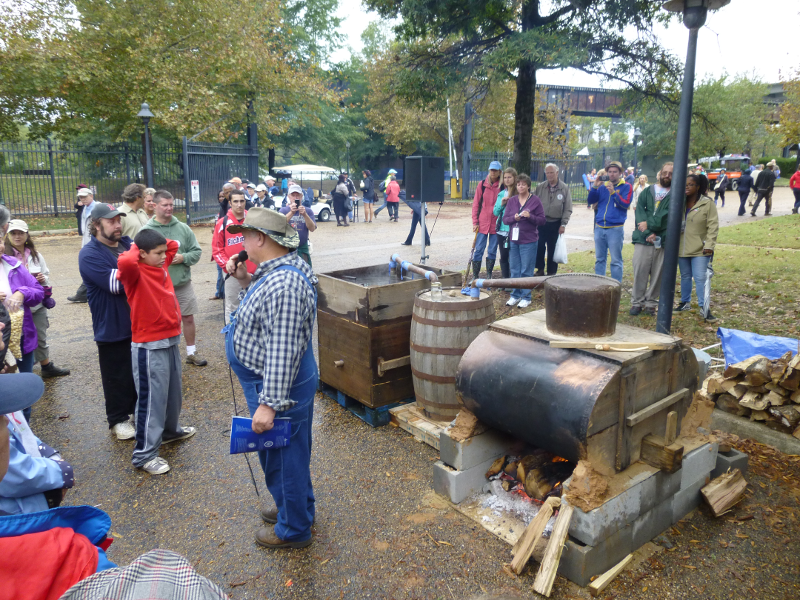
demonstration of moonshine making at Richmond Folk Festival, 2013

demonstration of moonshine making at Richmond Folk Festival, 2013
"Moonshine" is untaxed liquor. It can be manufactured from corn or other grains, but when thy are not available potatoes or other starch-rich foods can be fermented to produce alcohol. In jail, raisins and other foods are used to make "jailhouse hooch."
Sugar can be added to provide more carbohydrates as food for the yeast, which convert the carbohydrates into alcohol and carbon dioxide. Carbon dioxide is boiled away as a waste product when making distilled liquor, but trapped to keep the fizz in beer and sparking wine (champagne).
In 2012, The Virginia Department of Alcoholic Beverage Control had issued licenses for legal distilleries located in Albemarle County, Culpeper County, Fairfax County, Franklin County, James City County, Loudoun County, Norfolk, Richmond, Spotsylvania County, and Virginia Beach.1
"2012 Establishments by License Category - Cities" and "2012 Establishments by License Category -Counties," 2012 Annual Report, Virginia Department of Alcoholic Beverage Control, http://www.abc.state.va.us/admin/annual/annual.htm (last checked October 27, 2013)
The Bowman distillery in Spotsylvania County is the oldest legal distillery in Virginia. The original distillery was built on the family's Sunset Hills Farm in 1935, at the end of Prohibition. As Reston developed and land values increased, the Bowman family moved the distillery to Spotsylvania County in 1988. It now produces Virginia Gentleman bourbon as well as other liquor in a converted clothing factory (the old FMC Cellophane plant that once produced the inner linings for men's suits) located downstream of Fredericksburg.2
"Spirited museum in the works ," Fredericksburg Free Lance-Star, October 3, 2010, http://fredericksburg.com/News/FLS/2010/102010/10032010/579324 (last checked October 27, 2013)
Illegal distilleries or "stills" are concentrated in the rural mountainous counties. For years, far more sugar was sold in Franklin County than the local residents could ever eat.
Whiskey manufactured under "moonshine" rather than by state permission is not taxed, and therefore is dramatically less expensive. Some moonshine might be shared with friends, families, and trusted customers near where it is manufactured. However, the customers are primarily "nip joints" (unlicensed bars) in urban areas such as Richmond, Baltimore and Philadelphia.
Moonshine was sold in a Mason jar normally used for canning, sometimes with a peach on the bottom to give it a little bourbon-like color. Otherwise, "white lightning" is a clear fluid with an alcohol content comparable to grain alcohol, often above 100 proof. ("200 proof" is 100% alcohol.) It takes like unflavored vodka, and during Prohibition the cocktail/mixzed drink became popular to disguise the taste.3
"Nip Joints," Virginia Department of Alcoholic Beverage Control, http://www.abc.state.va.us/facts/nipjoint.html (no longer online); "Cocktail History in America: Prohibition (1910s-1933)," Virginia Tech, https://guides.lib.vt.edu/c.php?g=387023&p=3016455; "NASCAR's Moonshine Roots," NASCAR, February 10, 2023, https://www.nascarhall.com/blog/nascars-moonshine-roots (last checked October 22, 2023)
Moonshine is not aged in wooden barrels; it is sold as fast as it is made, and has a raw burning flavor. The taste may be rough, but the alcoholic kick can be felt quickly.
Good moonshine can "hold a bead" so a bubble at the surface on the edge of a glass jar stays intact. That surface tension indicates a high percentage (proof) of alcohol, rather than a watered-down product. If the bead bursts too quickly, indicating a low-proof product, buyers of illegal moonshine should not expect to get their money back by calling the Better Business Bureau or the Virginia Department of Agriculture and Consumer Services.
State and Federal government agencies try to stop illegal production of alcohol, in part to ensure that liquor is safe as well as taxed. Back in the early 1900's when car radiators were used to condense the vaporized alcohol into liquid phase, enough lead from the solder might end up in the moonshine to blind or kill the final consumer.3
"Distillation Safety – Things To Know Before You Start Distilling," Moonshine Distiller, December 31, 2013, https://moonshinedistiller.com/distilling-info/distillation-safety/ (last checked November 20, 2023)
The origins of NASCAR are linked with the development of skilled driving to elude revenue agents and transport the untaxed, illegal liquor from the mountains to the final market in coastal cities.
Franklin County in the Blue Ridge is traditionally considered the center of moonshining Virginia. Moonshining is concentrated in the mountains for several reasons, but primarily because there's a centuries-old tradition of converting corn crops into whiskey to simplify transport for sale outside of the region. Race car drivers now circling around NASCAR tracks can trace the heritage of that sport to drivers carrying moonshine from mountain stills to market, using cars souped up to outrun government revenue agents.
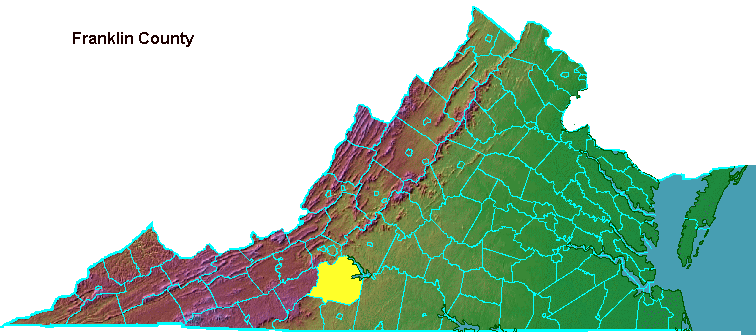
because roads in the mountains are bad, corn was concentrated into whiskey for transport
NASCAR driver Junior Johnson described he was motivated to modify cars to increase their speed while carrying a heavy load of Mason jars filled with illegal liquor:4
"NASCAR's Moonshine Roots," NASCAR, February 10, 2023, https://www.nascarhall.com/blog/nascars-moonshine-roots (last checked November 20, 2023)
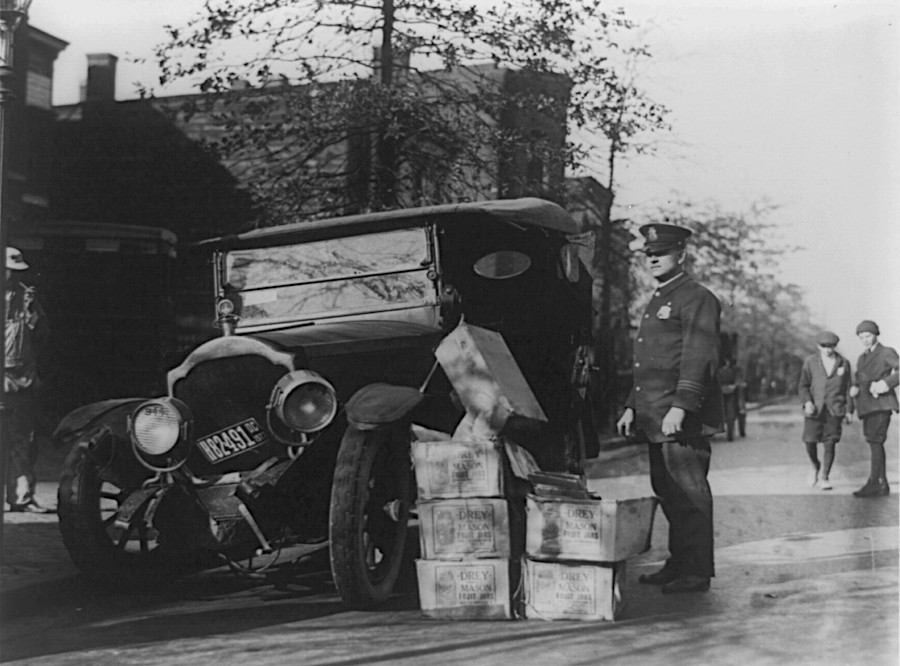
not every moonshine transporter escaped the police
Source: Libray of Congress, Policeman standing alongside wrecked car and cases of moonshine (November 16, 1922)
The roads in the Blue Ridge and the Appalachian Plateau have always been poor, due to the cost of construction. Farmers in the mountains might raise more than enough corn to feed families and livestock, but the cost of transporting the surplus to a market was too expensive. Once the bulky corn was concentrated into liquor, farmers could transport it and still make a profit - unless taxed too heavily.
That pattern dates back to the 1700's, and whiskey taxes helped the first president of the United States define the power of the Federal government.
The farmers of Western Pennsylvania rebelled in 1794 against a Federal tax on whiskey, imposed by Congress at Alexander Hamilton's suggestion. The Federal government needed revenue to pay for the Revolutionary War debts absorbed by the Federal government from the states, in the compromise that had resulted in the capital being located on the Potomac River. Two Virginians were key in suppressing the Whiskey Rebellion. George Washington assembled an army of over 10,000 troops - the largest force of "revenuers" ever created- to suppress what was portrayed as an armed rebellion against the new Federal government. (The creation of the Confederacy in 1860-61 was just one of many sectional threats to disunite the union of the United States...)
The force Washington assembled was far more than necessary, but Washington, Adams, and Hamilton wanted to ensure that the supremacy of the Federal government was clearly recognized. Virginia Governor Henry "Light Horse Harry" Lee actually led the troops from Bedford, Pennsylvania into the western part of the state. At that point, the rebellion dissolved and pardons were quickly issued for most participants.5
"The Whiskey Rebellion," Mount Vernon, http://www.mountvernon.org/educational-resources/encyclopedia/whiskey-rebellion (last checked October 27, 2013)
Moonshining does occur in city basements as well as mountains hollows. However, there are more job opportunities in the cities, so there's less incentive for people in urban areas to tackle the hard work of making illegal whiskey there.
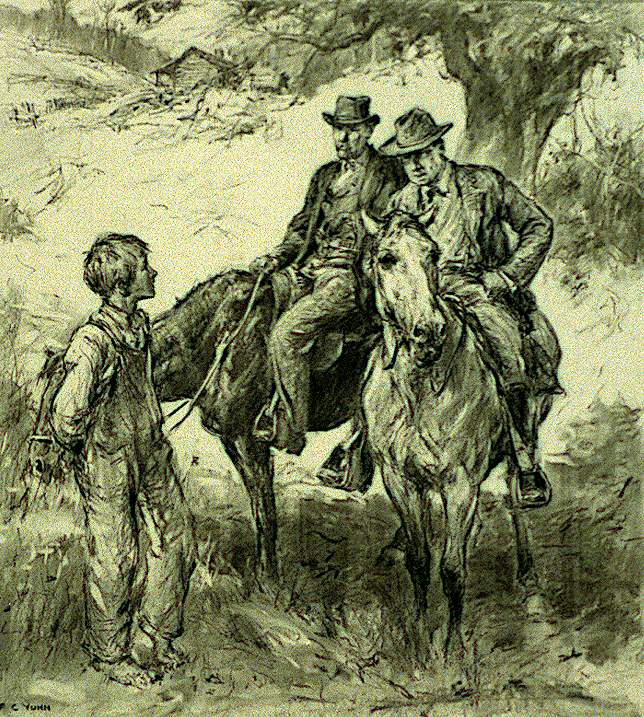
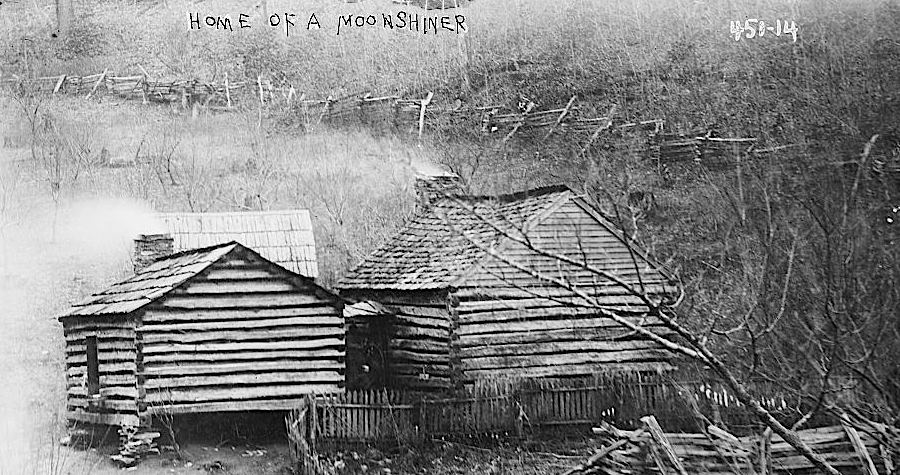
the folklore of moonshining focuses on settings in the mountains
Source: Libray of Congress, Bud Getchin's ten-year-old has a scared-rabbit look-- he knows that he is confronting them Revenues and Home of a moonshiner
Also, the distillation process requires substantial heat to boil the mash and separate the alcohol vapor from water vapor. Mountaineers could use wood, a cheap fuel. One reason for "moonshining" at night, in moonlight, was to hide the smoke from the eyes of informers and tax agents - but today, propane tanks offer a smoke-free alternative.
Amos Law was one of the most renowned moonshiners in Franklin and Pittsylvania counties. He sold to customers n Philadelphia, New York and Baltimore. He was charged with perjury after state and Federal agencies cooperated in Operation Lightning Strike and broke up three moonshining rings that produced nearly 500,000 gallons of untaxed liquor between 1992-1999. Amos Law claimed he had never hauled sugar or jugs for anybody. The jury found him not guilty, after his lawyer claimed he was confused by the question and that:6
"Franklin County moonshine legend Amos Law dies at 83," The Roanoke Times, February 11, 2019, https://www.roanoke.com/news/local/franklin_county/franklin-county-moonshine-legend-amos-law-dies-at/article_97cb9edd-7d66-504c-bf2b-17a4694c8a84.html (last checked April 5, 2020)
Amos Law trained his twin boys in the moonshining business. Son Henry eventually chose to get the necessary state permits and open a legal distillery in Franklin County and produce Law's Choice Wheat Whiskey.
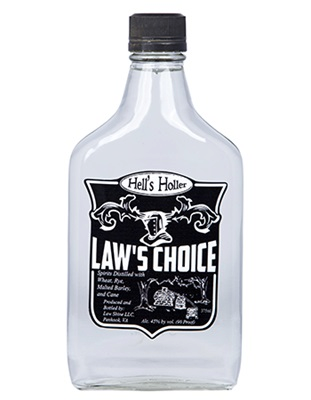
state-run liquor stores in Virginia now sell Laws Choice whiskey - and collect all required taxes
Source: Virginia Alcoholic Beverage Control Authority, Law's Choice Wheat Whiskey
Henry Law used small-batch recipes from his father and grandfather, processed through two "doublers" or "thumper" barrels with a 60 feet long "worm" made of 2-inch copper pipe to condense the alcohol vapor. Rather than produce high-proof liquor and then dilute it with water, he mixed the lower-alcohol whiskey that was first to condense with the higher-alcohol last part of the run to get the 90-proof product he desired.
Henry Law was a third-generation distiller, but the first to produce legal and taxed liquor. The name Law's Choice echoed a decision he made after first asking his father to teach him the moonshining business, which at one point landed him in jail. Amos Law warned his son Henry about the risks of violating the state's alcohol laws:7 "Offering 'Law's Choice," Franklin News-Post, July 3, 2017, https://www.thefranklinnewspost.com/news/offering-law-s-choice/article_49ccac48-5fed-11e7-bfa9-53486a5e5e97.html; "Franklin County moonshine legend Amos Law dies at 83," The Roanoke Times, February 11, 2019, https://www.roanoke.com/news/local/franklin_county/franklin-county-moonshine-legend-amos-law-dies-at/article_97cb9edd-7d66-504c-bf2b-17a4694c8a84.html (last checked April 5, 2020)
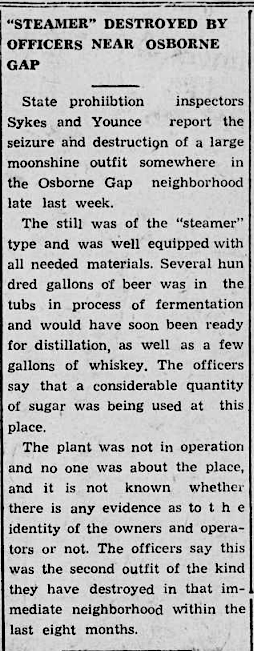
as World War II was ending in Europe, the war on moonshine continued in Dickinson County
Source: Library of Congress, Dickenson County herald (June 7, 1945)